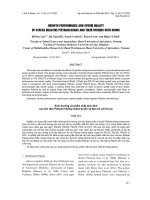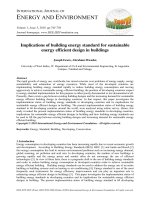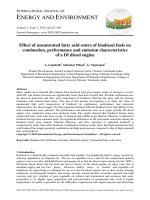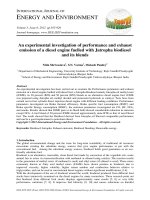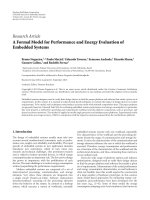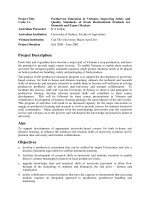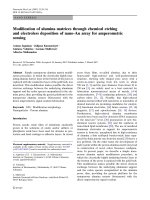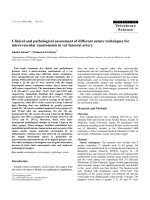performance and complexity co-evaluations of mpeg4-als compression standard for low-latency music compression
Bạn đang xem bản rút gọn của tài liệu. Xem và tải ngay bản đầy đủ của tài liệu tại đây (895.82 KB, 94 trang )
PERFORMANCE AND COMPLEXITY CO-EVALUATIONS
OF MPEG4-ALS COMPRESSION STANDARD FOR
LOW-LATENCY MUSIC COMPRESSION
A thesi s su b m i tte d in pa r t ial f u l fil l m e nt o f
t he re q uire m e n ts f o r the d egre e of
M a ster o f S c i e nce (Co m p u ter S cienc e )
By
ISAAC KEVIN MATTHEW
M. S. Physics
2 008
W right S tate U niv e r sity
WRIGHT STATE UNIVERSITY
SCHOOL OF GRADUATE STUDIES
21 August, 2008
I HEREBY RECOMMEND THAT THE THESIS PREPARED UNDER
MY SUPERVISION BY Isaac Kevin Matthew ENTITLED Performance
and Complexity Co-evaluation of MPEG4-ALS Compression Standard for
Low-latency Music Compression BE ACCEPTED IN PARTIAL
FULFILLMENT OF THE REQUIREMENTS FOR THE DEGREE OF
Master of Science, Computer Science.
Dr. Yong Pei (Advisor)
Assistant Professor, CS&E
Thomas Sudkamp
Interim Chair, CS&E
Committee on
Final Examination
Dr. Yong Pei
Assistant Professor, CS&E
Dr. Bin Wang
Associate Professor, CS&E
Dr. Thomas Hartrum
Assistant Research Professor, CS&E
Joseph F. Thomas, Jr., Ph.D.
Dean, School of Graduate Studies
iii
ABSTRACT
Matthew, Isaac Kevin. M.S., Department of Computer Sciences & Engineering, Wright State
University, 2008. Performance and Complexity Co-Evaluations of the MPEG4 ALS
Compression Standard for Low-Latency Music Compression.
In this thesis compression ratio and latency of different classical audio music tracks are
analyzed with various encoder options of MPEG4–ALS. Different tracks of audio music
tracks are tested with MPEG4-ALS coder with different options to find the optimum values
for various parameters to obtain maximum compression ratio with minimum CPU time
(encoder and decoder time). Optimum frame length for which the compression ratio
saturates for music audio is found out by analyzing the results when different classical music
tracks are experimented with various frame lengths. Also music tracks with varying sampling
rate are tested and the compression ratio and latency relationship with sampling rate are
analyzed and plotted. It is found that the compression gain rate was higher when the codec
complexity is less, and joint channel correlation and long term correlations are not significant
and latency trade off make the more complex codec options unsuitable for applications
where latency is critical. When the two entropy coding options, Rice code and BGMC (Block
Gilbert-Moore Codes) are applied on various classical music tracks, it was obvious that the
Rice code is more suitable for low-latency applications compared to the more complex
BGMC coding, as BGMC improved compression performance with the expense of latency,
making it unsuitable in real-time applications.
iv
TABLE OF CONTENTS
LIST OF FIGURES VII
LIST OF TABLES IX
1. INTRODUCTION 1
1.1 Objectives 1
1.2 Data Compression 2
1.3 Speech Coding/Lossy Audio Coding 4
1.4 Lossless Audio Coding 5
1.4.1 The Basic Principle 6
1.4.2 Filter 6
1.4.2.1 Prediction 7
1.4.2.2 Stereo Decorrelation 8
1.4.3 Entropy Coding 9
1.5 Comparison of Lossless Codecs 10
1.6 Summary 10
1.7 Organization of Thesis 11
2. INTERACTIVE MULTIMEDIA NETWORK APPLICATION 12
2.1 Telepresence 12
2.2 Network Terminology 14
2.3 Network Delay (Latency) Factors 15
2.3.1 Propagation Delay 15
2.3.2 Packetization Delay 16
2.3.3 Processing Delay 16
2.3.4 Queuing Delay 17
2.3.5 Transmission Delay 17
2.3.6 Coder Delay 18
2.3.7 De-Jitter Delay 18
2.4 Latency Requirment for Real Time Networking 19
v
2.5 Music Telepresence 21
2.5.1 Project Description 22
2.5.2 Features Supported by the Project 23
2.5.3 Performance 24
2.6 Summary 26
3. MPEG4-ALS 27
3.1 MPEG4-ALS Overview 27
3.1.1 General Features 28
3.1.2 Codec Structure 29
3.1.2.1 Encoder Structure 29
3.1.2.2 Decoder Structure 31
3.1.3 Linear Predictive Coding 32
3.1.4 Entropy Coding of Residual 35
3.1.5 Encoder Options 36
3.1.5.1 Block Length Switching 36
3.1.5.2 Random Access 36
3.1.5.3 Independent Coding 37
3.1.5.4 Joint Stereo Coding 37
3.1.5.5 Multi-Channel Correlation 38
3.2 Tuning MPEG4-ALS for Music Compression 39
3.2.1 Characteristics of Classical Music 40
3.2.2 Codec Complexity 41
3.3 Frame Length 43
3.4 Downsampling 43
3.5 Summay 44
4. TEST RESULTS AND ANALYSIS 46
4.1 Experimental Platform 46
4.2 Comparing Codec Complexity Levels 47
4.3 Multi-Channel correlation 52
4.4 Variations in Compression with Frame Lengths 54
4.4.1 Compression Ratio Vs Frame Length 58
4.4.2 Latency Vs Frame Length 61
4.4.3 KB/ms Saved Vs Frame Length 63
4.4.4 Sampling Rate Vs Compression Ratio 65
vi
4.4.5 Sampling Rate Vs Latency 68
4.4.6 Sampling Rate Vs KB/ms Saved By Compression 71
4.5 Entropy Coding of the Residual 74
4.6 Summary & Analysis 78
5. CONCLUSIONS AND FUTURE WORKS 79
5.1 Conclusions 79
5.2 Contributions 80
5.3 Future Works 81
REFERENCES 82
vii
LIST OF FIGURES
PAGE
1.1 Principle of Lossless Encoding 6
1.2 Principle of Lossless Decoding 6
3.1 MPEG4-ALS Encoder 31
3.2 MPEG4-ALS Decoder 32
3.3 Encoder of Forward-adaptive Prediction Scheme. 34
3.4 Decoder of Forward-adaptive Prediction Scheme 35
3.5 Differencial Coding 38
4.1 Codec Complexity Analysis 49
4.2 Codec Complexity Analysis - KB/ms saved 51
4.3 Codec Complexity Analysis with Inter-Channel Ccorrelation 53
4.4 Variations in Compression Ratio with Frame Length 8K 58
4.5 Variations in Compression Ratio with Frame Length 11K 59
4.6 Variations in Compression Ratio with Frame Length 22K 59
4.7 Variations in Compression Ratio with Frame Length 44K 60
4.8 Variations in Latency with Frame Length 8K 61
4.9 Variations in Latency with Frame Length 11K 61
4.10 Variations in Latency with Frame Length 22K 62
4.11 Variations in Latency with Frame Length 44K 62
4.12 Variations in File Size Reduction/ms with Frame Length 8K 63
4.13 Variations in File Size Reduction/ms with Frame Length 11K 64
4.14 Variations in File Size Reduction/ms with Frame Length 22K 64
4.15 Variations in File Size Reduction/ms with Frame Length 44K 65
4.16 Variations in Compression Ratio with Sampling Rate - Frame Length 128 66
4.17 Variations in Compression Ratio with Sampling Rate - Frame Length 256 66
4.18 Variations in Compression Ratio with Sampling Rate - Frame Length 512 67
viii
PAGE
4.19 Variations in Compression Ratio with Sampling Rate - Frame Length 1024 67
4.20 Variations in Compression Ratio with Sampling Rate - Frame Length 2048 68
4.21 Variations in Latency with Sampling Rate - Frame Length 128 69
4.22 Variations in Latency with Sampling Rate - Frame Length 256 69
4.23 Variations in Latency with Sampling Rate - Frame Length 512 70
4.24 Variations in Latency with Sampling Rate - Frame Length 1024 70
4.25 Variations in Latency with Sampling Rate - Frame Length 2048 71
4.26 Variations in KB/ms Saved with Sampling Rate - Frame Length 128 72
4.27 Variations in KB/ms Saved with Sampling Rate - Frame Length 256 72
4.28 Variations in KB/ms Saved with Sampling Rate - Frame Length 512 73
4.29 Variations in KB/ms Saved with Sampling Rate - Frame Length 1024 73
4.30 Variations in KB/ms Saved with Sampling Rate - Frame Length 2048 74
4.31 Audio Encoding Block Diagram 75
4.32 Variations in Compression Ratio when Rice Codec or BGMC is applied 76
4.33 Variations in Latency when Rice Codec or BGMC is applied 76
4.34 Variations in KB/ms saved when Rice Codec or BGMC is applied 77
ix
LIST OF TABLES
PAGE
1.1 Comparison of Lossless Codecs 10
3.1 MPEG4-ALS Encoder Options 41
3.2 Audio Sample Rate and Common Use 44
4.1 Comparison of Codec Complexity & Performance 47
4.2 Comparison of Codec Complexity & Performance 48
4.3 Comparison of Codec Complexity & Performance 48
4.4 Comparison of Codec Complexity with KB/ms Saved 50
4.5 Comparison of Codec Complexity & Correlations 52
4.6 Variation in Latency and Compression Ratio with Frame Length 8K 54
4.7 Variation in Latency and Compression Ratio with Frame Length 8K 54
4.8 Variation in Latency and Compression Ratio with Frame Length 8K 55
4.9 Variation in Latency and Compression Ratio with Frame Length 11K 55
4.10 Variation in Latency and Compression Ratio with Frame Length 11K 55
4.11 Variation in Latency and Compression Ratio with Frame Length 11K 56
4.12 Variation in Latency and Compression Ratio with Frame Length 22K 56
4.13 Variation in Latency and Compression Ratio with Frame Length 22K 56
4.14 Variation in Latency and Compression Ratio with Frame Length 22K 57
4.15 Variation in Latency and Compression Ratio with Frame Length 44K 57
4.16 Variation in Latency and Compression Ratio with Frame Length 44K 57
4.17 Variation in Latency and Compression Ratio with Frame Length 44K 58
4.18 Comparison of BGMC and Rice Codes 75
4.19 Comparison of BGMC and Rice Codes KB/ms Saved 77
x
ACKNOWLEDGEMENTS
I am forever obliged to my Lord and Savior Jesus Christ for coming into my life and being
with me all the time, filling me with hope, purpose and peace. Without His blessings, I never
would have done this thesis.
I would like to record my gratitude to Dr. Yong Pei, for his supervision, advice and
guidance. He has assisted me in numerous ways, including, editing the writings, summarizing
the results and in particular giving insightful ideas. My sincere thanks also go to Dr. Bin
Wang and Dr. Thomas Hartrum for being members of my thesis committee. I am thankful
that in the midst of their busy schedule, they accepted to be members of my thesis
committee.
I am grateful to all the staff and faculty of the Dept. of Computer Science and Engineering
at Wright State University for giving me the opportunity and assistance to conduct research
and study. I am thankful for DAGSI(Dayton Area Graduate Studies Institute) for providing
me with full tuition assistance throughout my graduate program.
I am indebted to my parents for their unfailing love and support throughout my life. No
words can express how grateful I am for the love and encouragement of my wife Leeba. I
would also like to thank my brother, Andrew for his unflinching assistance throughout my
MS program.
xi
I am thankful for all the members of Dayton Bible Chapel and LexisNexis Bible Study
Group for their persistent prayers and thoughtfulness.
I am thankful for my manager Mr. Andrew Lloyd and supervisor Mr. Paul Gossard for
giving me the opportunity to work in LexisNexis with a flexible schedule.
Last, but not the least, I would like to thank all my friends, co-workers, relatives, and well
wishers for their support and inspiration.
xii
To my wife, Leeba
1
Chapter 1
Introduction
Internet is now playing a very significant role in our daily life. Effective streaming of
different types of media like speech, audio, video, text and images are critical for
interactive applications through the Internet. Due to the limitation of bandwidth, at any
given time, the ability of the Internet to transfer data is fixed. For multimedia applications
involving high data transfer, one should consider compressing the data before streaming.
By effectively compressing the data significant improvements of data throughput can be
achieved.
1.1 Objective
Telepresence is the most effective communication tool for remote collaborations.
Telepresence is a very time-sensitive application in which the transmission must operate in
real time. In order to create the perception of real-time communication between end
users, the network delay should be very small. For telepresence in general and music
telepresence in particular, the delay should be less than 100 ms for acceptable
performance. For good performance the delay should be less than 50 ms. In this thesis a
careful study of the effects of applying data compression techniques in minimizing overall
delay of music telepresence is analyzed.
2
There is obviously a trade of between compression delay (coding delay) and network
transmission delay. Compression can save bandwidth and reduce the transmission delay
but with the expense of encoding and decoding time.
Here we have used classical music tracks to co-evaluate the performance and complexity
of MPEG 4-ALS codec by applying various encoding options. In short, the objective of
this study is to find the possibility of using data compression techniques to advance the
state of network-based telepresence by minimizing the overall delay within reasonable
limits.
1.2 Data Compression
Data compression seeks to reduce the number of bits used to store or transmit
information by the identification and extraction of source redundancy, which is connected
with statistical inference. Compression helps reduce the consumption of expensive
resources, such as disk space or transmission bandwidth but at the expense of extra
processing that may be detrimental to some applications. The task of compression
consists of two components, an encoding algorithm that takes a message and generates a
“compressed” representation and a decoding algorithm that reconstructs the original
message or some approximation of it from the compressed representation.
3
These two components are typically intricately tied together since they both have to
understand the shared compressed representation.
As is the case with any form of communication, compressed data communication only
works when both the sender and receiver of the information understand the encoding
scheme. The theoretical background of compression is provided by information theory
and rate-distortion theory.
The two basic terms referred in interactive data compression are compression ratio and
latency, which are calculated as follows;
Compression ratio = original size / compressed size
Latency = encoding time + decoding time
The amount of compression that can be achieved depends mainly on the efficiency of
algorithm and the amount of redundancy in the source whereas the latency depends on
the efficiency of algorithm and hardware efficiency (such as CPU speed). Data
compression can be divided into two main types, the lossless and lossy compression.
Lossless compression can be used when exact reconstruct of the original is essential.
Lossless compression schemes are reversible, i.e., it can recover the exact original data
after compression, but it may fail to compress data containing no discernible patterns. The
lossless data compression methods typically also offer a tradeoff between latency and
compression ratio.
Lossy compression will result in a certain loss of accuracy in exchange for a substantial
increase in compression. Lossy compression is more effective when used to compress
4
graphic images and digitized voice where losses outside visual or aural perception can be
tolerated.
Most lossy compression techniques can be adjusted to different quality levels, gaining
higher accuracy in exchange for less effective compression. The lossy data compression
methods typically offer a three-way tradeoff between latency, compression ratio and
quality loss.
1.3 Speech coding/Lossy Audio coding
In speech and lossy audio coding the quality is based on the properties of human auditory
perception. Speech compression uses a model of the human vocal tract to express
particular signals in a compressed format. As speech production model is available,
speech can be coded very efficiently. But due to the complexity of audio signals such as
music, such a model would be too complex to implement and hence the lossy encoding of
music is usually not as efficient as speech coding.
The lossy audio compression will try to eliminate information that is inaudible to the ear.
The audio compression algorithms rely on the field of psychoacoustics (the study of
human sound perception).
The signals become inaudible to ear when they obscure or mask each other. These occur
under three conditions namely, threshold cut-off, frequency masking and temporal
masking.
Threshold cut-off: For humans, hearing is limited to frequencies between about 20 Hz and
20,000 Hz (20 kHz). Human ear detects sounds as air pressure variations measured as
5
Sound Pressure Level (SPL). Therefore, human ear cannot detect sound if the variations in
the SPL are below a certain threshold in amplitude.
Frequency Masking: Some of the signal components that exceed the hearing threshold may
be masked by louder components that are near it in frequency. These shadowed or
masked components will not be heard.
Temporal Masking: A sudden increase in sound can temporarily mask neighboring signals.
Sounds that occur before and after the volume increase can be masked.
Lossy coding can exploit these phenomenons to eliminate those signals and can achieve
significant compression performance.
1.4 Lossless Audio coding
Lossless compression compresses a signal without loss of information. After decoding, the
resulted signal is identical to the original signal. Compared to lossy compression, lossless
compression achieves a very limited compression ratio.
It is difficult to maintain all the data in an audio stream and achieve substantial
compression expecially when the audio is music due to its high complexity.
As one of the key methods of compression is to find patterns and repetition, more chaotic
data such as audio doesn't compress well.
In most cases, the values of audio samples change very quickly, generic data compression
algorithms don't work well for audio, and strings of consecutive bytes don't generally
appear very often.
6
Since lossless audio codecs have no quality issues, the efficiency can be estimated by
Speed of compression and decompression (latency)
Compression ratio
Software and hardware support
Robustness and error correction
1.4.1 The Basic Principle
Lossless audio compression is split into two main parts - filtering and entropy coding as
shown in Fig. 1.1 and Fig. 1.2.
Entropy
Coding
Original
Residual
Bitstream
FILTER
Fig.1.1 Principle of Lossless Encoding
Bitstream
Lossless
Reconstruction
Residual
Entropy
coding
Fig.1.2 Principle of Lossless decoding
FILTER
1.4.2 Filter
A filter essentially takes a set of numbers and returns a new set. For the purposes of
lossless audio compression, the transformation must be done in such a way that it is
7
reversible and hopefully the transformation will reduce the range of numbers so that they
compress better.
Filtering or transforming signals (e.g. Fast Fourier Transform (FFT)) slightly decorrelate
(make flat) the spectrum, thereby allowing traditional lossless compression at the encoder
to do its job; integration at the decoder restores the original signal. Many lossless codecs
(e.g. FLAC, Shorten, TTA etc.) use linear prediction to estimate the spectrum of the
signal.
At the encoder, the estimator's inverse is used to whiten the signal by removing spectral
peaks while the estimator is used to reconstruct the original signal at the decoder.
1.4.2.1 Prediction
In lossless codec, most of the filters used are constructed out of predictors. A predictor
here is a function, which is passed the previous sample and returns a prediction of the
next. The predictor may of course internally store some state or history.
A filter can thus be created out of any predictor, such that the output value (residual) is
the difference between the actual sample and the prediction, i.e.
Residual = Sample – Prediction
and then to recover the original sample when decoding, uses:
Sample = Residual + Prediction
A number of different predictors are used in lossless codecs. Delta filter is a simple filter,
which uses last-sample as prediction. In more complicated filters, they adjust the weight
between the last-sample and the preceding prediction.
8
Prediction = last-sample * weight, and we adaptively adjust the value weight.
A simple method to adapt weight would be to increase it when the last prediction was too
low, and decrease it when the last prediction was too high.
Compression performance can further be improved by successively applying multiple
filters to the data. (i.e., the second filter takes the output of the first filter as input). Also
predictors, which use „n‟ preceding samples in prediction, can increase performance.
Another approach to improving upon this predictor is to create a single predictor, which
takes into account the past n samples. It then needs to store a corresponding array of n
weights, and will require loops to adapt the weights and to calculate the prediction. Most
filters are based on these ideas. Filter selection depends on the performance as well as the
encoding and decoding speed.
1.4.2.2 Stereo Decorrelation
Most lossless audio compressors, try to take into account the similarity between channels
in stereo audio to improve compression performance. The standard way to do this is to
convert the left channel (L) + right channel (R) signals to X+Y, where X = L - R and
Y = R + (X / 2).
However, audio signals with low correlation between channels may decrease performance.
A simple example is a file where one channel is silent - after the X+Y transformation both
channels would contain the signal, thus potentially doubling the resultant file size.
In efficient lossless audio codecs, the predictors take into account samples from both
channels. Thus, more complex correlation between the channels is better taken into
9
account of, and it adapts better to the actual level of correlation existing in the signal
rather than simply assuming that the channels are correlated as with the X+Y
transformation.
1.4.3 Entropy coding
The term entropy denotes amount of information in a signal. When entropy is lower more
predictable is the signal. From a compression perspective, lower the entropy, greater will
be the compression ratio. Claude Shannon formulated the theory of entropy of a system
encoded into binary format, using bits/samples as a measurement method.
H = -
P
x
log
2
P
x
(2.1)
In (2.1) H is the entropy of the signal and P the probability of a symbol occurring in a
signal. H is the theoretical minimum code required to code the given data stream to
binary.
The whole purpose behind the filters reducing the range of the samples is the assumption
that smaller numbers can be stored more efficiently. Shannon's entropy measures the
information contained in a message as opposed to the portion of the message that is
determined (or predictable). After the data has been quantized into a finite set of values, it
can be encoded using an entropy coder to give additional compression.
By entropy, we mean the amount of information present in the data, and an entropy coder
encodes the given set of symbols with the minimum number of bits required to represent
them. Two popular entropy-coding schemes are Huffman coding and Arithmetic coding.
x
10
These coding methods require prior knowledge of the signal statistics to decode the
signals efficiently. Rice coding and cascade coding are used for signals with Laplacian
distribution and stepwise distribution respectively.
1.5 Comparison of Lossless codecs
Features
FLAC
WavPack
Monkey's
TTA
LPAC
MPEG-
4 ALS
Shorten
Real
Lossless
Streaming
Yes
Yes
No
No
No
Yes
No
Yes
Open source
Yes
Yes
Yes
Yes
No
Yes
Yes
No
Multi-channel
Yes
Yes
No
Yes
No
Yes
No
No
OS support
All
All
All
All
Win/
Linux
/Sol
All
All
Win/
Mac/
Linux
1.6 Summary
The current chapter describes the role of data compression in audio communication and
an overview of data compression techniques. Basic terminology and theory behind data
compression are discussed. Detailed description of various techniques used in
lossy/speech coding and the theoretical difference between lossy and lossless coding are
given. The basic constituent of audio lossless compression such as filters and entropy
coding techniques are discussed in details. Detailed explanations of how the predictors
efficiently exploit the correlation between adjacent samples are also given in this chapter.
Stereo decorrelation techniques used to exploit correlation between adjacent channels are
discussed. Finally a general comparison of different lossless codecs is given in tabular
form.
Table 1.3 Comparison of Lossless codecs
11
1.7 Organization of Thesis
The rest of the thesis is organized as follows: In Chapter 2, the motivation, scope,
challenges and progress of network-enabled remote telepresence project (music-
telepresence) is reviewed. Later on in this chapter, compression and latency Challenges in
networking applications are discussed. In Chapter 3, an overview of MPEG-4 audio
lossless coding standard (ALS) is given along with a detailed description of different
techniques used to optimize the MPEG-4ALS codec for Internet related musical
applications. In Chapter 4, results, performance evaluations and analysis of all proposed
techniques to optimize MPEG4-ALS codec are given. Finally, we provide our conclusions
and future research directions in Chapter 5.
12
Chapter 2
Interactive Multimedia Network
Applications
Interactive multimedia networking is used in almost all area of human life including
medical, corporate and entertainment fields. Interactive multimedia is widely used in
advertising, information system, online multimedia training, patient monitoring networks
and multimedia conferencing etc. In order to understand the challenges associated with a
particular interactive multimedia network application, it is necessary to understand the
level of interactivity and multimedia data transfer associated with the application. Network
performance requirements depend on nature of these applications and the level of
interactivity involved in these applications. For interactive applications involving
continuous bi-directional multimedia data transfer, it requires network with sufficient
bandwidth to satisfy the specific need.
2.1. Telepresence
Multimedia conferencing is the most effective modern tool of communication. Advanced
multimedia conferencing makes it possible to allow persons to feel as if they were present
at a common location other than their true locations.
13
A set of technologies that allow combining human factors of communication with the
latest videoconferencing technologies is referred as telepresence. Telepresence make it
possible to interact each other effectively by talking, hearing, seeing and communicating
by other means. Telepresence not only provides effective virtual business meeting
opportunities, but also provide support to other areas like the emergency and security
services, entertainment and education industries.
Development of a network-enabled remote telepresence platform has the potential to
broadly impact society through the benefits of improved interpersonal interactions, the
economic advantages afforded by the elimination of physical barriers to collaboration and
the need to travel, and the ability to provide new and improved services to economically
and culturally deprived, geographically remote, or physically handicapped populations is
the motivation behind the music telepresence project. Its application can vary from
interactive performances and collaborations by performing artists to remote medical
diagnosis, collaboration and treatment. However, the existing efforts to achieve network-
based telepresence have yet to reach the ideal level of providing a widely accessible,
medium-transparent, acceptably immersive interactive audio/video environment between
remote locations while requiring only commodity network services and terminal platforms.
Here we emphasis on the challenges in telepresence applications involving transmission of
audio (music) channels. In order to understand the challenges in telepresence and to
measure various aspects of network and protocol performance, it is essential to know the
basic network terminology.
